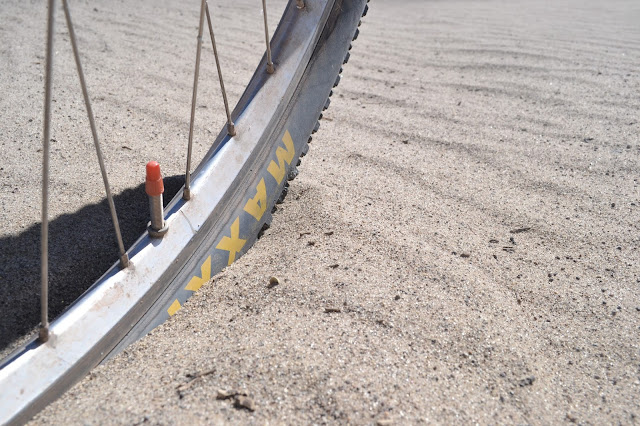 |
| Riding into the sky on the Salar de Uyuni |
Our Route
We entered Bolivia at Copacabana, riding by Lake Titicaca for a few days then avoiding the city of La Paz by cutting south at Batallas and crossing through Viacha. The road continues almost straight south through Coro Coro and then out to the main paved road (highway 4). We followed the pavement until the turnoff for Cosapa, where we turned onto some sandy roads across the altiplano through Sacabaya and Sabaya. From there we crossed the Salar de Coipasa and then the Salar de Uyuni, ending that section of the ride in the town of Uyuni.
South of Uyuni we took the main road through San Cristobal, heading south to Quetena Chico to climb the volcano Uturuncu. The classic lagunas route then took us to the Hito Cajon border crossing and ultimately to Chile.
Food
Unlike in Peru, small towns we passed through rarely had well-stocked shops. Often shops only sold a collection of processed cookies and sodas. Knowing this ahead of time, we brought a lot of our food from Peru for the first part of the country, and then restocked in Uyuni and supplemented that food in small towns. We passed a few towns south of Uyuni that also had decent shopping opportunities. See here for details.
We didn't eat out nearly as much, although any medium size town has a restaurant if you ask around enough.
 |
| Benefits of hydrothermal activity: hot springs! |
Water
In the altiplano, there are rarely good water sources between towns. Rivers are often caked with mud or, especially in the extreme south, filled with noxious minerals from the hydrothermal activity. That being said, we found water in every single tiny town. Without water, no one could live there! Fill up in the evening, because often pipes freeze overnight. There are plenty of places; we never had to carry water for more than a day or so (max 5 liters.)
In cities such as Uyuni, there are regulations on water use. Don't be surprised if the water or electricity is shut off for part of the day.
Shelter
On the altiplano things can get really windy. We almost always found it necessary to search out a windbreak for the night in order to keep our tent from blowing around all night or worse. Luckily, abandoned adobe houses (or part of one), and llama corrals are commonly found along the road. Small towns usually have health centers (puesto de salud) whose walled backyards can provide a decent camp spot.
 |
| Our tent behind an old adobe wall |
Alojamientos, or accommodation, was available only in large cities. Many small towns in Sur Lipez, the extreme south of the country, seemed to exist primarily for the purpose of lodging and feeding jeep tourists. In these places it is possible to find lodging, or to camp. Price per person was usually around 40 bolivianos. Pricey compared to Peru!
People
We heard from other cyclists that people in Bolivia were standoffish and unfriendly, but we found the exact opposite. In general, people we met were super friendly, welcoming, and helpful. Often when we were riding into a town, a whole crowd of people would come out to welcome us. We were invited in for meals multiple times and had no issues with any sort of crime.
 |
| A nice guy helping us out with a water pump |
The weather varies greatly depending on when you're visiting. In general, the altiplano is supposed to have good weather from April to October. Rainy season starts around December. For the week after we entered Bolivia in late October, we frequently hit large thunderstorms in the afternoon.
 |
| An evening thunderstorm near Coro Coro |
When we reached the southern regions there was no more rain, but wind picked up significantly in the afternoons. Sometimes it would start blowing as early as 8 am! In addition to the wind, be prepared for highly fluctuating temperatures. Often it would go from hot to freezing within a span of hours.
Road Conditions
Even with the challenging weather conditions, it's Boliva's poor roads that create the biggest challenge for cyclists. Often we were battling with washboard and deep sand at the same time. That being said, it is obvious that there has been some improvement in road quality over the last few years, and we were able to ride, rather than push, almost 100% of the time. When we knew challenging road conditions were ahead, we made sure to bring extra food and water so that if progress was slow we could ride short days if we wanted.
 |
| Deep sand can be a challenge |
 |
| Typical mess of jeep tracks |
Since the salars and the Reserva Natural de Fauna Andina Eduarda Avaroa, are extremely popular with tourists, jeep traffic is common along the roads (really it's Toyota traffic, but who cares?). During peak season we've heard that the dust can be a bit overwhelming, but during mid-November when we were there, the traffic wasn't too much of a bother. We found the jeep drivers, though somewhat crazy behind the wheel, to be generally courteous and helpful. Some drivers even gave us leftovers from their lunch meals, much appreciated, and the jeeps also provided a backup plan in case we ever needed more water.
 |
| Bolivia: difficult... |
 |
| ...but uniquely incredible |
No comments:
Post a Comment